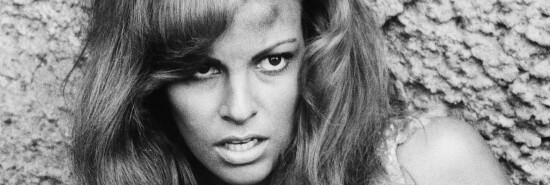
Raquel Welch, 1940-2023
Daniel Ross Goodman
The past year in film has been the year of the sex symbol biopic, with the greatest male sex symbol of the postwar era (Elvis Presley) and the greatest female sex symbol of the era (Marilyn Monroe) both getting their due in Oscar-nominated movies (though, to be sure, the latter deserves better than the execrable Blonde, whose only nomination is for Ana de Armas’s heart-wrenching performance as Ms. Monroe.) A very close second, however, for the titleholder of greatest female sex symbol of the era was Raquel Welch, who died this week at the age of 82.
Welch was born in Chicago as Raquel Tejada and was raised in San Diego, where she developed an interest in ballet. At 17, she was obliged to give up dancing because, as she recounted somewhat ironically, “my instructor broke it to me that I really didn’t have the figure for ballet.” Fortunately for her and her millions of admirers, that was hardly the end of her performing arts career. After winning several California beauty pageants, she became a local news weathercaster and married the agent and publicist James Welch in 1959. Though they divorced five years later, and though Raquel Welch would have three more marriages over the course of her life, she kept the Welch name throughout.
In the early ’60s Raquel Welch began to explore other screen-related possibilities. After a few modeling gigs and after making several contacts with professionals in the film world, she landed a few spots, mostly one-off appearances, on TV shows like McHale’s Navy and Bewitched, as well as an uncredited role in the 1964 Elvis movie-musical Roustabout. Her first credited movie appearance came that same year in A House Is Not a Home.
Raquel Welch’s Hollywood breakthrough came two years later when she appeared in Fantastic Voyage, a science fiction movie based on the Isaac Asimov novel about a group of doctors and technicians who are shrunken to microscopic size so that they can travel through the body of an important military scientist and unclog a clot in his brain. The movie, which won Oscars for visual effects and art direction, managed to predict both nanorobotic surgery as well as the 1989 comedy hit Honey, I Shrunk the Kids. Sporting a bouffant hairdo, Raquel Welch mostly stands around passively as her male colleagues do all the serious deliberating. Every once in a while, she’s given a few anodyne lines to exclaim, like “He’s gone!”; “Hurry!”; “Open it!”; and “I never imagined it could be anything like this.” Though she was said to be highly intelligent, it was clear she was not chosen for the role because of her brainpower. This was made even more obvious when the filmmakers had her dress down into a white skin-tight diving suit, a scene memorably parodied in a Simpsons spoof of the movie wherein Marge, compelled to wear a similarly scantily clad outfit in contrast to Homer’s baggier attire, wonders, “Why is my swimsuit so revealing?”
Raquel Welch was then cast in One Million Years B.C., a prehistoric adventure fantasy extravaganza in which her character, Loana, takes up with a caveman from a rival tribe and braves a world beset by volcanic eruptions, dinosaur attacks, giant turtles, and other sundry primeval ordeals. Raquel Welch had even fewer lines in One Million Years B.C. than she had in Fantastic Voyage, but it was her appearance in a deerskin bikini in the former that rocketed her to superstardom.
Raquel Welch’s acting career also encompassed theater, where she earned leading roles in the Broadway plays Woman of the Year (1982) and Victor/Victoria (1997) and also starred in an off-Broadway version of the George Bernard Shaw play The Millionairess (1998). But her mainstay was the screen, where she accumulated over 80 acting credits in her 50-year film and television career, as well as a Golden Globe for her performance in The Three Musketeers (1973).
Her most memorable role in a movie, however, was one in which she did not act at all. In The Shawshank Redemption (1994), Andy Dufresne (Tim Robbins) is able to escape from prison because of the posters that his friend Red (Morgan Freeman) smuggles in for him. These posters artfully conceal the tunnel that Andy has been painstakingly carving through his cell wall for 19 years. The poster that hangs over his tunnel during the movie’s climactic scene — the poster the warden throws a rock through, precipitating one of the greatest goosebump-inducing moments in movie history — is the iconic image of Raquel Welch in the deerskin bikini from One Million Years B.C. For those of us like myself, for whom The Shawshank Redemption is one of the defining movies of our lives, Raquel Welch was no mere sex symbol; she is a symbol of perseverance through adversity, of the ingenuity needed to break through seemingly immovable obstacles, and, most of all, of hope, “a good thing, maybe the best of things, and no good thing ever dies.”
Daniel Ross Goodman is a Washington Examiner contributing writer and the author, most recently, of Somewhere Over the Rainbow: Wonder and Religion in American Cinema.
